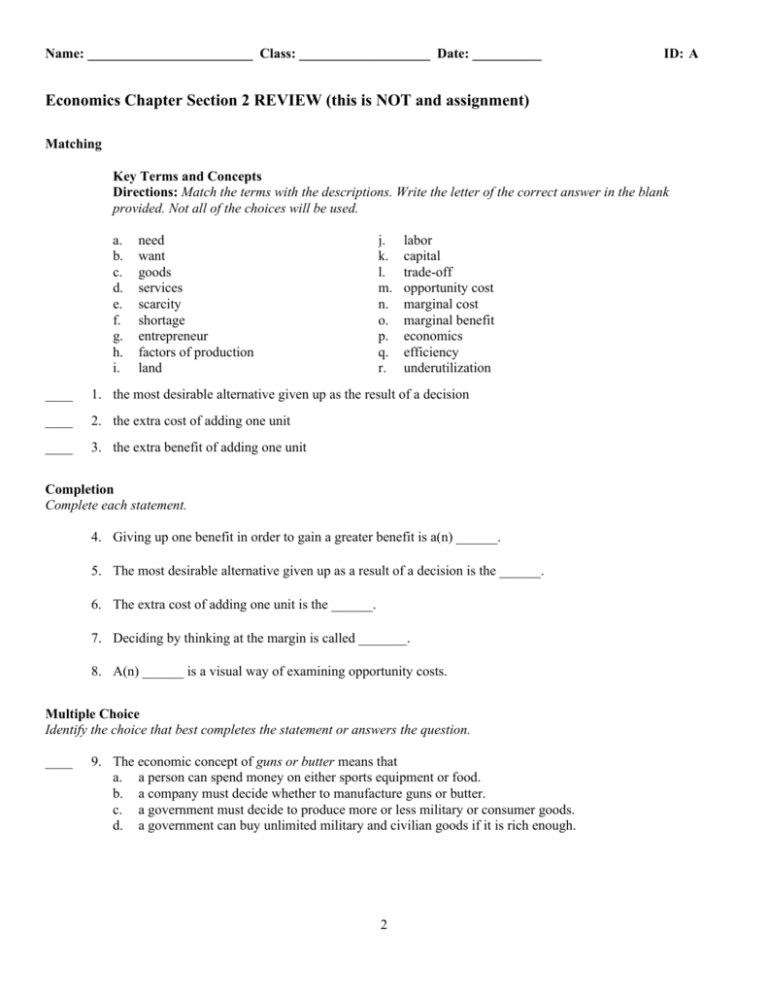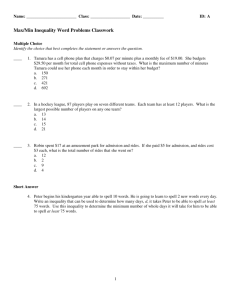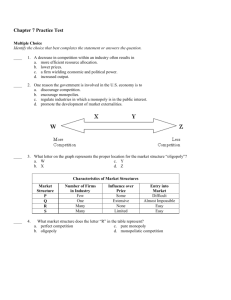ExamView - Untitled.tst - maximumachievementprogram.org
advertisement

Name: ________________________ Class: ___________________ Date: __________ ID: A Economics Chapter Section 2 REVIEW (this is NOT and assignment) Matching Key Terms and Concepts Directions: Match the terms with the descriptions. Write the letter of the correct answer in the blank provided. Not all of the choices will be used. a. b. c. d. e. f. g. h. i. need want goods services scarcity shortage entrepreneur factors of production land j. k. l. m. n. o. p. q. r. labor capital trade-off opportunity cost marginal cost marginal benefit economics efficiency underutilization ____ 1. the most desirable alternative given up as the result of a decision ____ 2. the extra cost of adding one unit ____ 3. the extra benefit of adding one unit Completion Complete each statement. 4. Giving up one benefit in order to gain a greater benefit is a(n) ______. 5. The most desirable alternative given up as a result of a decision is the ______. 6. The extra cost of adding one unit is the ______. 7. Deciding by thinking at the margin is called _______. 8. A(n) ______ is a visual way of examining opportunity costs. Multiple Choice Identify the choice that best completes the statement or answers the question. ____ 9. The economic concept of guns or butter means that a. a person can spend money on either sports equipment or food. b. a company must decide whether to manufacture guns or butter. c. a government must decide to produce more or less military or consumer goods. d. a government can buy unlimited military and civilian goods if it is rich enough. 2 Name: ________________________ ID: A ____ 10. If you choose between two summer jobs, the one you do not choose is the ______ of your decision. a. trade-off b. opportunity cost c. decision at the margin d. opportunity at the margin ____ 11. Every decision involves trade-offs because a. everyone has to make decisions. b. everyone’s resources are limited. c. some people have more money than others. d. some decisions are made for business, others for society. ____ 12. The government of a country must make a decision between increasing military spending and subsidizing wheat farmers. This is an example of a. a guns or butter issue. b. decision-making at the margin. c. underutilization of resources. d. the law of increasing costs. ____ 13. You bought two new CDs with the last $30 in your checking account, and your next payday is on Monday. What is the opportunity cost of these CDs? a. the difference between the cost to produce the CDs and the price you paid for them b. the $30 check that you wrote for the CDs c. the night out with your friends that you miss because you can’t afford it now d. the satisfaction of knowing you are the first of your friends to have these CDs ____ 14. Making a decision at the margin is possible only in situations where a. the available opportunity costs are unclear or complicated. b. the available alternatives can be divided into increments. c. there are more than three different types of alternatives to consider. d. there are differences in the amount of time each alternative will consume. ____ 15. A decision is made at the margin when each alternative considers a. a different trade-off than the others. b. where the most costly alternative will be. c. what the “all or nothing” alternative will be. d. cost and benefit ranked in progressive units. ____ 16. When a theater owner considers whether to install another row of seating, she is a. underutilizing her resources. b. experiencing a shortage. c. using human capital. d. thinking at the margin. ____ 17. Which of the following is the kind of decision that can be made at the margin? a. whether or not to hire new workers b. whether or not to go on a vacation c. whether or not to build an extra room on a home d. whether to have a dog or a cat as a pet 2 Name: ________________________ ID: A ____ 18. What can a decision-making grid do? a. tell you the right decision to make b. show you every possible consequence of your decision c. help you determine some of the opportunity costs for your decision d. show you every possible benefit of your decision Options Work 1 hour Work 2 hours Work 3 hours Work 4 hours Work 5 hours Decision Making at the Margin Benefits Opportunity Costs 1 hour’s pay 1 hour of study or recreation time 2 hours’ pay 2 hours of study or recreation time 3 hours’ pay 3 hours of study or recreation time 4 hours’ pay 4 hours of study or recreation time 5 hours’ pay 5 hours of study or recreation time ____ 19. Jed has one hour available after school each weekday. The rest of the afternoon is taken up by other activities. He is evaluating what to do with those 5 hours. According to the chart, which option has the least benefit? a. working 1 hour b. working 2 hours c. working 4 hours d. working 5 hours ____ 20. If Jed uses the grid to decide to earn the maximum pay, what will be the trade-off? a. There won’t be any trade-off, only benefits. b. He will add another hour to the available time to use for study. c. He will have a balance of work and study or recreation time. d. There will be no time for study or recreation. Short Answer 21. Why is a “guns or butter” decision an example of a trade-off? 3 ID: A Economics Chapter Section 2 REVIEW (this is NOT and assignment) Answer Section MATCHING 1. ANS: OBJ: TOP: 2. ANS: OBJ: NAT: 3. ANS: OBJ: NAT: M PTS: 2 DIF: L3 REF: A.9 1.2.2 Summarize the concept of opportunity cost. STA: G.3 Economic Choices | Opportunity Cost N PTS: 2 DIF: L3 REF: A.11 1.2.3 Describe how people make decisions by thinking at the margin. 2.1| 2.2| 2.3 TOP: Economic Choices | Margin O PTS: 2 DIF: L3 REF: A.11 1.2.3 Describe how people make decisions by thinking at the margin. 2.1| 2.2| 2.3 TOP: Economic Choices | Margin COMPLETION 4. ANS: trade-off PTS: OBJ: TOP: 5. ANS: 2 DIF: L3 REF: A.8 1.2.1 Explain why every decision involves trade-offs Economic Systems | Trade-offs opportunity cost PTS: OBJ: TOP: 6. ANS: 2 DIF: L3 REF: A.9 1.2.2 Summarize the concept of opportunity cost. Economic Systems | Opportunity Cost marginal benefit PTS: OBJ: NAT: 7. ANS: 2 DIF: L3 REF: A.11 1.2.3 Describe how people make decisions by thinking at the margin. 2.1| 2.2| 2.3 TOP: Economic Systems | Marginal Cost cost/benefit analysis PTS: OBJ: NAT: 8. ANS: 2 DIF: L3 REF: A.11 1.2.3 Describe how people make decisions by thinking at the margin. 2.1| 2.2| 2.3 TOP: Economic Systems | Cost-Benefit Analysis decision-making grid PTS: 2 DIF: L3 REF: A.11 OBJ: 1.2.2 Summarize the concept of opportunity cost. KEY: Economic Systems | Opportunity Cost 1 STA: G.3 STA: G.3 STA: G.3 ID: A MULTIPLE CHOICE 9. ANS: C The term guns or butter refers to the choice between spending money on military or domestic needs. PTS: 3 DIF: L3 REF: A.9 OBJ: 1.2.1 Explain why every decision involves trade-offs STA: G.3 TOP: Economic Systems | Opportunity Cost 10. ANS: B Opportunity cost is the most desirable alternative not chosen when a decision is made. PTS: 3 DIF: L3 REF: A.9 OBJ: 1.2.2 Summarize the concept of opportunity cost. STA: G.3 TOP: Economic Systems | Opportunity Cost 11. ANS: B Every decision involves trade-offs because scarcity always exists. PTS: 3 DIF: L3 REF: A.9 OBJ: 1.1.1 Explain why scarcity and choice are the basis of economics STA: G.2 TOP: Economic Systems | Trade-offs 12. ANS: A Economists and politicians use the term “guns or butter” to describe a country’s choice of spending money on military or domestic needs. PTS: 3 DIF: L3 REF: A.9 OBJ: 1.2.1 Explain why every decision involves trade-offs STA: G.3 TOP: Economic Choices | Trade-Offs 13. ANS: C The most desirable alternative somebody gives up as the result of a decision is the opportunity cost. PTS: 5 DIF: L4 REF: A.9 OBJ: 1.2.2 Summarize the concept of opportunity cost. STA: G.3 TOP: Economic Choices | Opportunity Cost 14. ANS: B Thinking at the margin means making decisions about adding or subtracting one unit. PTS: 3 DIF: L3 REF: A.11 OBJ: 1.2.3 Describe how people make decisions by thinking at the margin. NAT: 2.1| 2.2| 2.3 TOP: Economic Systems | Thinking at the Margin 15. ANS: D Making decisions at the margin means deciding whether to add or subtract progressive units. PTS: 3 DIF: L3 REF: A.11 OBJ: 1.1.3 Define the three factors of production and the differences between physical and human capital. TOP: Economic Systems | Thinking at the Margin 2 ID: A 16. ANS: D Thinking at the margin describes decisions about the cost and benefit of providing more or less of a good or service. PTS: 3 DIF: L3 REF: A.11 OBJ: 1.2.3 Describe how people make decisions by thinking at the margin. NAT: 2.1| 2.2| 2.3 TOP: Economic Choices | Margin 17. ANS: A Thinking at the margin describes decisions on how much more or less one should do economically. PTS: 3 DIF: L3 REF: A.11 OBJ: 1.2.3 Describe how people make decisions by thinking at the margin. NAT: 2.1| 2.2| 2.3 TOP: Economic Choices | Margin 18. ANS: C A decision-making grid shows the opportunity costs for the possible choices a person can make. PTS: 3 DIF: L3 REF: A.11 OBJ: 1.2.2 Summarize the concept of opportunity cost. STA: G.3 TOP: Economic Choices | Decision-Making Grids 19. ANS: A A benefit is what a person gains from a decision. In this case, working one hour has the least benefit because it offers the least amount of pay. PTS: 3 DIF: L3 REF: A.11 OBJ: 1.2.1 Explain why every decision involves trade-offs STA: G.3 TOP: Economic Choices | Benefits 20. ANS: D If Jed chooses to work during all five hours, there will be no time left for other activities. PTS: 5 DIF: L4 REF: A.11 OBJ: 1.2.1 Explain why every decision involves trade-offs TOP: Economic Choices | Trade-Offs STA: G.3 SHORT ANSWER 21. ANS: When a government makes a “guns or butter” decision, it makes a choice between military or domestic spending. In choosing, the government trades off one type of benefit for another. PTS: 5 DIF: L3 REF: A.9 OBJ: 1.2.1 Explain why every decision involves trade-offs TOP: Economic Choices | Trade-Offs 3 STA: G.3









